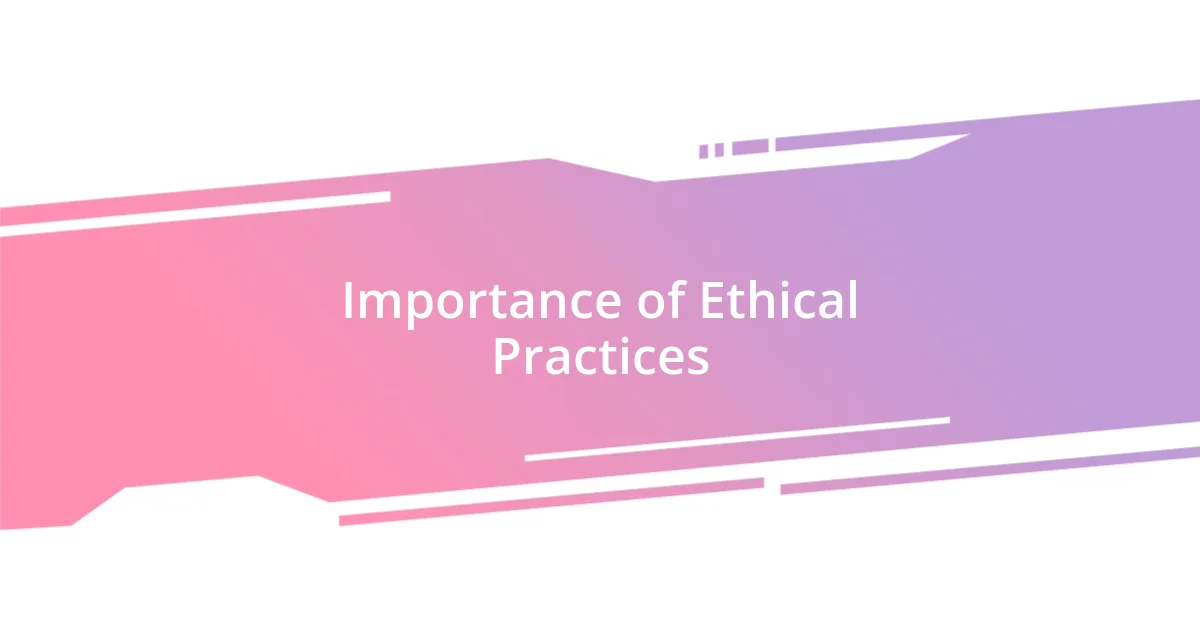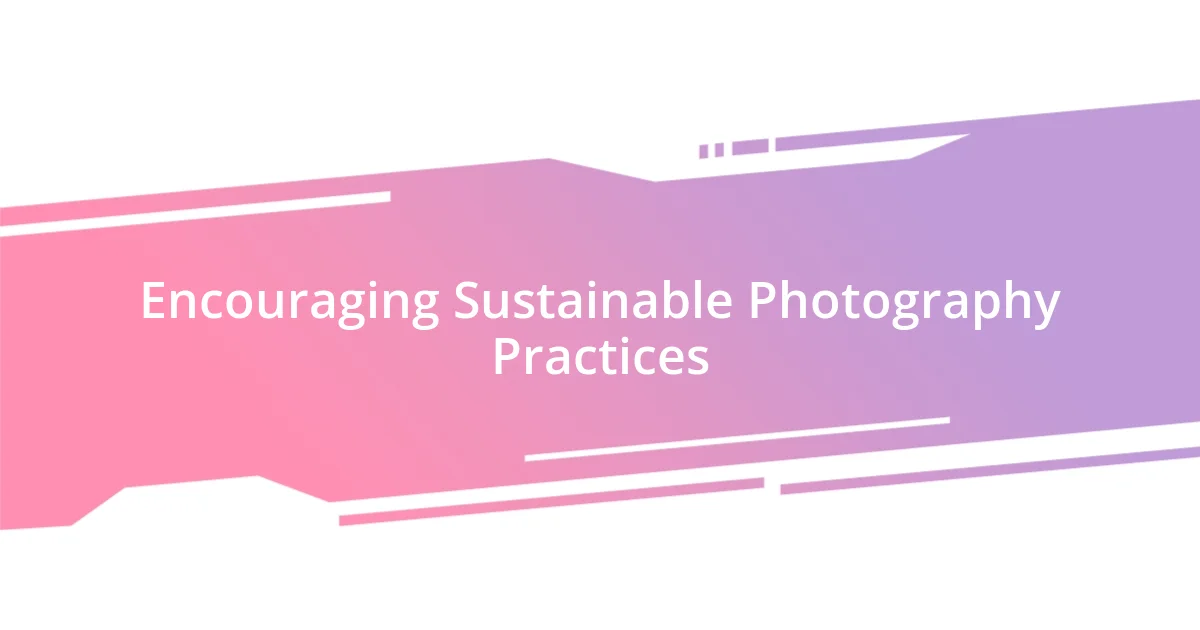Key takeaways:
- Ethical travel photography emphasizes respect and responsibility, requiring photographers to obtain consent and engage meaningfully with their subjects.
- Sharing images responsibly involves providing context that honors the subjects and avoids exploitation, ensuring a narrative that reflects their stories authentically.
- Sustainable photography practices advocate for the preservation of environments and local cultures while promoting awareness and respect for the communities involved.

Understanding Travel Photography Ethics
Understanding travel photography ethics is about more than just capturing beautiful images; it’s a complex interplay of respect and responsibility. I remember taking a candid shot of a street vendor in a bustling market. The moment felt raw and genuine, yet I hesitated—was it right to immortalize someone’s daily struggle without their consent? These are the questions that often linger in my mind as I navigate the world behind the lens.
When I think about ethics in photography, it often revolves around the principle of “do no harm.” It’s crucial to consider the impact of our presence and our photos on the people and places we document. I once photographed a traditional ceremony in a remote village. The joy in their eyes was undeniable, but I also sensed their wariness. Were they comfortable being seen as mere subjects for my portfolio? This experience taught me that ethical photography requires a dialogue, a connection, and sometimes, stepping back to let the moment exist without judgment.
It’s easy to get lost in the beauty of travel photography, but I’ve found it’s imperative to balance that with sensitivity. Have you ever seen a photo that felt exploitative rather than beautiful? I certainly have, and it made me reflect deeply on my responsibilities as a photographer. Ethical travel photography invites us to not only tell stories but to tell them with integrity, ensuring that the essence of a culture or individual is honored and preserved.

Importance of Ethical Practices
Ethical practices in travel photography are essential because they foster respect for the individuals and cultures being portrayed. I remember attending a cultural festival where my excitement led me to capture every moment without pause. As I reviewed my shots later, I realized some images crossed a line, capturing potentially vulnerable moments without the participants’ awareness. This experience reinforced my understanding that photography should elevate voices rather than diminish them.
To ensure ethical practices in photography, I often consider the following points:
- Obtain consent: Always ask for permission before photographing individuals, especially in intimate or private settings.
- Be aware of context: Understand the cultural significance of events and respect the traditions of the communities you are documenting.
- Avoid exploitation: Strive to portray subjects in a way that honors their dignity and personal story, rather than reducing them to mere subjects.
- Share the story: Use your platform to amplify the narratives of those you photograph, rather than prioritizing your own fame or visibility.
- Self-reflect: Regularly assess your motivations and the impact of your work; ask yourself if you’re contributing positively to the communities you engage with.
In my experience, adhering to these principles not only enriches the storytelling but also nurtures a broader understanding and appreciation for diverse cultures.

Respecting Local Cultures
Respecting local cultures is a vital aspect of travel photography. I recall visiting an indigenous community during a workshop on traditional crafts. I was captivated by their intricate weaving techniques, but I quickly realized my presence might disrupt their process. Instead of just snapping away, I chose to participate, ask questions, and learn from them. This not only deepened my understanding but also built trust, enabling me to capture their essence authentically.
In another instance, while documenting a vibrant festival in a foreign country, I observed how various photographers rushed in, shooting without regard for the participants’ comfort. Many locals seemed guarded, unsure of how they would be represented. I decided to converse with the festival-goers first, share my intentions, and ask if I could take their photos. This approach transformed the interaction into a collaboration, allowing me to portray the joy and spirit of the event genuinely. It’s moments like these that remind me that respect opens doors to unforgettable narratives.
The balance between capturing stunning visuals and honoring local cultures can be challenging. I’ve often faced internal struggles over whether my photography could unintentionally objectify rather than celebrate. What I’ve learned is that genuine curiosity and empathy can turn a fleeting moment into a powerful story about humanity. When we approach our subjects with respect, we become part of their narrative rather than just outside observers.
| Positive Practices | Negative Practices |
|---|---|
| Ask for consent | Shooting without permission |
| Engage with the community | Remaining distant and detached |
| Honor their story | Exploiting vulnerability |
| Share cultural context | Cultural appropriation |

Seeking Permission for Photographs
When it comes to seeking permission for photographs, I find the process deeply rewarding. There was a moment during a visit to a bustling market in Morocco where I spotted a vendor selling vibrant spices. Instead of intruding on his space, I approached him with a polite request to take his picture. His unexpected smile and willingness to share his story transformed that moment into much more than just a snapshot. It’s a reminder that asking for permission not only builds trust but can also lead to richer stories behind the images.
I often reflect on the times I neglected to seek permission and how those moments left me feeling uneasy. Like when I photographed a group of children playing without asking, I later realized that it could have made them uncomfortable or exposed their lives in a way they hadn’t consented to. Each time I bypass permission, I remind myself of the emotional weight that accompanies our choices. Are we genuinely capturing moments, or are we imposing our lens on someone else’s life without consideration?
Ultimately, seeking permission is more than a basic courtesy; it’s about valuing the humanity of those we photograph. I’ve learned that during my travels, these interactions often evolve into conversations that deepen my understanding of the local culture. Each “yes” I receive not only enriches my portfolio but also affirms that the subjects feel empowered and respected. Isn’t it amazing how a simple act of asking can transform a photograph into a meaningful connection?

Navigating Privacy Concerns
Navigating privacy concerns in travel photography can feel tricky, yet I’ve learned that trust is key. Once, while exploring a quiet village, I noticed a wonderful candid moment unfolding in front of me. Instead of snapping my camera immediately, I paused to gauge the situation, noticing that the locals were in an intimate conversation. I respected their space and captured the essence of the moment in my mind rather than on my camera. Wouldn’t it be great if we all understood when to just observe?
I still remember a more uncomfortable incident. At a popular tourist destination, I spotted a group of teenagers laughing and enjoying themselves. In my eagerness to document the joy, I raised my camera without thinking. Their expressions shifted from happiness to unease. I felt a pang of regret; it dawned on me that I had invaded a private moment. Moments like these illustrate how important it is to be aware of our subjects’ feelings. Am I seeking a stunning photo at the expense of someone’s comfort?
This reflective approach has led me to make conscious choices about when and how to capture someone’s story. For instance, during a serene sunset at a beach, I approached a couple who were deep in conversation. Rather than just taking their picture, I asked if they’d mind sharing their thoughts about that moment. The conversation enriched my understanding of their experience, and my photograph turned into a lasting memory of their story. It’s in these interactions where the true essence of travel photography thrives—when we recognize that there’s a fine line between art and intrusion.

Sharing Images Responsibly
When it comes to sharing images responsibly, I’ve come to realize that context is everything. A few years ago, I captured a stunning sunset silhouette of local fishermen at work. When I later shared that image online, I made sure to include a caption acknowledging their labor and the importance of sustainable fishing. I often think: how would I feel if my work was shared without acknowledgment? Providing context not only honors the subjects but also educates viewers, creating a more meaningful dialogue around the image.
Another time, during a cultural festival, I shot some joyous moments of people dancing and celebrating. Before posting, I reached out to a few individuals to get their thoughts and consent. It was eye-opening! Their stories about what the festival meant to them transformed my approach to sharing. Isn’t it fascinating how a simple conversation can enhance the narrative behind an image? I believe we have a responsibility not just to the photograph, but to the people within it, ensuring that their stories are told authentically and with respect.
I also think about the implications of sharing sensitive content. While exploring a region affected by natural disasters, I took some powerful shots, but I hesitated before posting. I knew these images could evoke strong emotions, but I wanted to ensure they conveyed hope and resilience rather than despair. When I finally shared them, I framed the images with an empowering message that highlighted the community’s strength. I wondered: am I inspiring awareness or simply provoking pity? Sharing responsibly means being mindful of the impact our images can have, both on our audience and on those we photograph.

Encouraging Sustainable Photography Practices
As I journey deeper into the world of travel photography, I’ve learned that sustainable practices go beyond just snapping beautiful shots—they involve respecting our surroundings. On one trip to a lush rainforest, I witnessed fellow photographers unintentionally trampling delicate flora while trying to capture the perfect frame. It struck me: how often do we prioritize our photos over the very environment we cherish? I started to view my role as a guardian, encouraging others to stay on paths and avoid disturbing wildlife. Every small effort counts towards preserving the beauty we want to capture.
In my travels, I’ve made it a point to engage with local communities about sustainable photography. During a visit to a community that thrives on ecotourism, I discovered that the locals had established guidelines for photographers. They wanted their stories told without exploitation, ensuring their heritage is respected. Learning this shifted my perception completely. I began to ask myself: how can my lens shine a light on their story while promoting sustainability? Since then, whenever I shoot, I also promote their initiatives, using my platform to amplify their voices and encourage others to follow suit.
I often reflect on the materials I use in photography gear, too. Several years ago, I invested in eco-friendly alternatives, like biodegradable lens wipes and sustainably sourced camera bags. Not only have they proven to be effective, but they also resonate with my values as a responsible traveler. Have you ever considered how your choices impact the places you love? This realization really transformed my approach, making me feel a genuine connection to every destination I visit. Sustainable photography isn’t just a checklist; it’s a mindset that shapes how I interact with the world.












